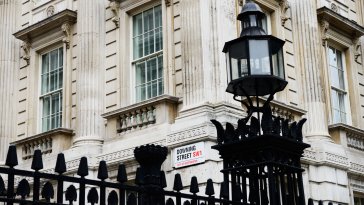
Carry me home
- 19 April 2024 (5 min read)
Markets are getting close to pricing out any interest rates cuts for 2024. That seems a little extreme. In Europe and the UK, inflation is likely to ease further. In the US, sticky prices in parts of the services sector have stalled the disinflation process, but the core personal consumption expenditure (PCE) deflator– the Federal Reserve’s (Fed) key measure of inflation – looks to be moving in the right direction, even if the consumer price inflation index (CPI) is a little less well behaved. Long-dated Treasury and other sovereign benchmark bonds do not look overly exciting and won’t until rates are eased. Before that happens, credit markets are more interesting, with carry dominating the return picture. Short duration and spread continue to be the dominant themes in bond markets.
One, two but not six
The short-term view is that bonds look a little oversold. Since December, the yield on the US Treasury 10-year benchmark has risen by 80 basis points (bp). There have been similar increases in other sovereign benchmark yields. Yield volatility at the long end of the curve can be driven by several things – changing views on monetary policy, economic data and geopolitical events. What is more interesting is the shifts we have seen in terms of expectations about what central banks will do this year. Predictions for where policy rates will be at the end of 2024 have changed markedly. This has been most extreme in the US where the market has shifted from 3.65% to just shy of 4.90%. In other words, from expecting six cuts from the Fed, the market is now pricing in less than two. For the European Central Bank (ECB) the market has moved from 2.0% to 3.10% for the expected policy rate (seven moves to three), and for the Bank of England (BoE), year-end pricing has moved from 3.50% to 4.70% (seven to less than two moves). No wonder fixed income returns are negative year to date.
At the moment it is hard to see where bonds go. The potential for escalation in the Middle East could eventually start to impact global markets more meaningfully. Higher oil prices would disrupt the inflation and growth outlook. Together with the ongoing Ukraine conflict, there is a potential risk-off scenario where bonds benefit from safe-haven flows out of risk assets. However, this is hard to predict and trade. For now, the underlying fundamental and policy story needs to be monitored closely.
Do policy makers know where they are?
Leaving aside the global security situation, the shift in rate expectations begs the question: “What has changed?” Some will argue that central bankers made a mistake in encouraging market expectations of a rapid easing of policy in 2024 when inflation was still above target and when they should have been considering the neutral rate of interest was much higher than previously expected. Policy was not as tight as it should have been, and easing would be a mistake. There has been quite a lot of rowing back from the dovish stance of central bankers since the end of last year. Of course, the data has also encouraged policy makers to be more cautious. The disinflation process may have stalled in some economies. US headline consumer price inflation was 3.5% in March, up from 3.1% in January and the core rate is stuck close to 4.0%. A lot of data has suggested the Fed should wait. Data dependency, it appears, leads to policy uncertainty. That uncertainty leads to higher interest rate premiums which will raise borrowing costs through the economy.
Before the Fed?
In Europe, the inflation decline has continued. The headline rate dropped to 2.4% in March - it was 6.9% in March 2023. UK headline inflation was 3.2% in March, down from 3.4% in February. Given the base effects related to the UK’s energy pricing structure, headline inflation should be a lot lower in April. While activity data might be improving, inflation does appear to be moving lower on this side of the Atlantic. Hence there’s more discussion about the ECB or the BoE, or both, cutting interest rates before the Fed. Markets are priced for one full 25bp cut from the ECB over June/July and for one full cut from the BoE by September. My view is that both could cut rates in June. For me, that tends to the view that the gilt market is good value at current yields. More attractive still are short-dated sterling corporate bonds. The yield to worst on the one-to-three-year part of the sterling corporate bond index is 5.7% currently. That is more attractive than sterling cash rates with the prospect of some capital gains once the BoE moves.
Do not mention hiking
A notable absence of suggestions over the notion that the Fed might need to hike rates has been from the Fed itself. Chair Jerome Powell pushed back on rate cut expectations at the International Monetary Fund Spring meetings in Washington, recognising the stalling of the disinflation process in the US. However, there is no public record of Fed officials admitting they have shifted from rate cuts to rates on hold to rate hikes. But there is a lack of confidence among investors that the Fed is on top of the inflation situation and, if it isn’t, what can it do about it.
Markets tend to focus on the consumer price data as the key inflation gauge. It has many computational issues which can lead to outsize movements relative to the true inflation picture. There is a tendency to forget the Fed’s preferred measure is the PCE. That stood at 2.8% in February, a full 200bp lower than in February 2023. Using the core PCE, the current Fed Funds central rate is 245bp above the inflation rate (compared to 145bp using the core CPI). Obviously, the core PCE is still above the 2.0% target and the Fed will want to see lower numbers. A simple projection based on historical monthly changes in the index suggests it will remain slightly above 2.0% for the remainder of this year (in the decade to the end of 2020 it averaged 1.6%). However, the point is that the core PCE is still trending lower while the CPI trend has stalled.
Stickier still
The bearish case for US bonds is that the Fed does hike and explicitly raises its long-term estimate of the neutral rate. Say the neutral rate is 3.5%-4.0% and the yield curve reverts to being positively sloped, putting 10-year yields at 5.0%-5.5%. That could be justified by inflation remaining stickier and there being a higher term premium because of concerns over the US fiscal situation. This is not a forecast, but it is a scenario that investors should consider. Treasury yields have been below 5% since the global financial crisis – a period that saw massive central bank buying and then a pandemic that stalled the global economy for several quarters. What I am suggesting is that 5%-6% would not be abnormal historically for an economy that looks as though it can sustain nominal growth in the 5%-7% range.
Making up
Even without this scenario happening, the outlook for long duration in Treasuries is only moderately exciting if inflation and growth are lower and the Fed cuts rates aggressively. I did some number crunching this week and if the current income return on the Treasury index stayed the same, so that the total return on a Treasury portfolio would mostly come from carry, it will take until mid-2029 for all the losses realised since September 2020 (when the total return index peaked) to be made good. The drawdown from the peak in the index is still ongoing in Treasuries, in contrast to global equities and high yield. Short-duration investors have done much better. The drawdown from the Fed hiking impact on total returns ended in November of last year for the one-to-three-year part of the US corporate bond market. Higher carry and shorter duration have been the winning strategies in fixed income and may continue to be so.
Better carry
But the past is the past. Few alpha-seeking investors would have held a passive Treasury portfolio for the last five years. What most of my readers will be interested in is what happens in the next year given the Treasury market sets the tone for other bond and credit markets and risk assets in general. The 10-year Treasury yields just under 4.6%. Yields on short-dated bonds are higher. The weighted yield on the ICE US Treasury market index is 4.8%. The income return on that index for the last year has averaged 22bp per month, or 2.7% per year. That has been rising and will rise further as the average coupon on the market increases. So, the make-good point on the Fed tightening era losses will come more quickly than suggested above. The Treasury market should return between 4% and 5% going forward. Add on another 90bp-100bp for investment grade credit and 350bp-400bp for high yield and you have an interesting US fixed income market. Any Fed hike will disrupt the returns for the US and other markets, but we are in a higher yield world now so income is what investors should be looking at from bonds. Stable yields would not be a bad outcome (so far, the market has not re-tested that 5% level on 10-year Treasury bonds).
Art of noise
The choice of a particular inflation index as the target for monetary policy is never optimal. Remember the UK used to target retail price inflation! People strip out outlying price increases, adjust weights and construct inflation indices based on different income cohorts’ spending patterns, to get a more ‘suitable’ inflation rate. Is there such a thing as the true measure of inflation? Probably not, and that is why central banking is more art than science. The choice of a target level is also something more arbitrary than subject to any natural laws of economics. Central banks were lucky in the first half of this century as globalisation, the rise of the low-cost China export machines, and technological progress meant negative goods price inflation. Service sector inflation mostly stuck between 3% and 4%. The average came out near 2%. But if the target had been 2.5% or 3% then central bankers would not be in such a tizz.
There is no appetite for killing economic growth just to get that additional 50bp-100bp lower inflation rate, especially when pricing behaviour post-COVID-19 has not normalised in some sectors and is certainly not impacted by slight changes in the overnight cost of money. At this moment, central banks cannot raise rates because it would scupper their credibility and cannot rush to ease because it would scupper their credibility. Market interest rates and bond yields reflect that. Tactically, Treasuries and gilts are a buy here, and credit has become more attractive over the last month given the back-up in yields and the widening of spreads. The year of the bond is hard going, but carry should carry us home.
Season end
It is sad, as a Manchester United fan, to be reduced to getting pleasure from seeing your biggest historical rivals lose. It would have been hard to take Manchester City winning the treble in consecutive seasons, but thanks to Real Madrid that is not going to happen. Liverpool will also end up with less than some of their more unrealistic supporters had hoped for. United still have a chance of silverware, depending on being able to beat Coventry this weekend and then a one-off against Chelsea or City. But it has been an awful season with the only highlights being the emergence of another crop of talented young players and the last-minute goal to beat Liverpool in the FA Cup. Hopefully, there are better things to come. For now, though, bring on cricket, the Euros and the Olympics.
(Performance data/data sources: Refinitiv DataStream, Bloomberg, as of 18 April 2024, unless otherwise stated). Past performance should not be seen as a guide to future returns.
Disclaimer
This document is for informational purposes only and does not constitute investment research or financial analysis relating to transactions in financial instruments as per MIF Directive (2014/65/EU), nor does it constitute on the part of AXA Investment Managers or its affiliated companies an offer to buy or sell any investments, products or services, and should not be considered as solicitation or investment, legal or tax advice, a recommendation for an investment strategy or a personalized recommendation to buy or sell securities.
Due to its simplification, this document is partial and opinions, estimates and forecasts herein are subjective and subject to change without notice. There is no guarantee forecasts made will come to pass. Data, figures, declarations, analysis, predictions and other information in this document is provided based on our state of knowledge at the time of creation of this document. Whilst every care is taken, no representation or warranty (including liability towards third parties), express or implied, is made as to the accuracy, reliability or completeness of the information contained herein. Reliance upon information in this material is at the sole discretion of the recipient. This material does not contain sufficient information to support an investment decision.
Issued in the UK by AXA Investment Managers UK Limited, which is authorised and regulated by the Financial Conduct Authority in the UK. Registered in England and Wales, No: 01431068. Registered Office: 22 Bishopsgate, London, EC2N 4BQ.





